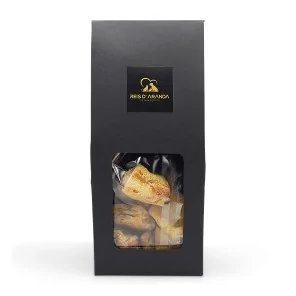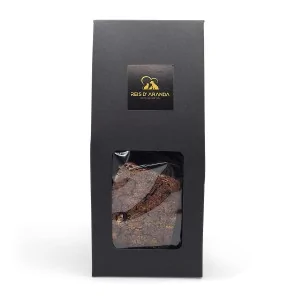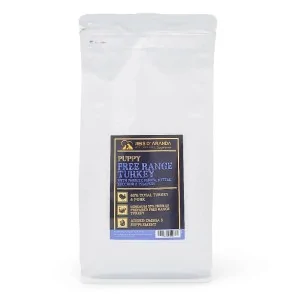Its name says it all: the Vienna blue rabbit comes from Austria. Not only is it beautiful with its shiny blue-grey...
THE ROTTWEILER
INTRODUCTION
The Rottweiler is a molosser-type breed of dog originating in Germany, although it was also used in ancient Rome. It was known as the ‘Rottweil butcher dog’ - in German: Rottweiler Metzgerhund - because it was used to protect and herd livestock and pull butcher's carts loaded with meat, along with other products for the market.
THE HISTORY OF THE ROTTWEILER
Although a versatile breed used in recent times for many purposes, the Rottweiler is primarily known as one of the oldest herding breeds. A multi-faceted rally and stock protection dog, it is capable of working all types of livestock in a variety of conditions.
The origin of the breed probably lies in the Roman Empire. In those times, the Roman legion travelled with working dogs to gather the livestock needed to feed the army. The main ancestors of the early Rottweilers during this time is believed to be the Roman herding dog.
These dogs moved with the Romans further into the alpine regions, where they protected the people and drove the cattle, as well as the Swiss cattle dogs. In the region of Rottweil (the origin of their name) in Germany, very close to Stuttgart, these dogs were crossed with the native dogs, from which a mixture arose. From then on, the main task of the Rottweiler was to guard and drive large livestock and to defend his master and his possessions. It got its name, ‘Rottweil butcher's dog’, from the former imperial city of Rottweil. The butchers bred him only according to his performance and usefulness. In the course of time, it developed into an unbeatable protection and driving breed, which was also used as a pulling dog.
This region became an important livestock area, and the descendants of the Roman cattle dogs proved their worth in driving and protecting cattle from thieves and wild animals. Rottweilers were used by butchers travelling between markets during the Middle Ages to protect money bags tied around their necks. However, as railways became the main method of getting around, the breed declined greatly and was on the verge of extinction.
When, in the early 20th century, dog breeds were sought for police service, the Rottweiler was tested. It was quickly demonstrated that this dog was perfectly suited to the tasks of the police service, as it shows a strong character, its great musculature, power and lunging make its opponents very fearful. That is why in 1910 it was officially designated as a police dog.
The preparation for the First World War caused a great demand for police dogs, which led to a resurgence of interest in the Rottweiler. During World Wars I and II, Rottweilers were put into service in various roles, including as messenger dogs and for the delivery of explosive devices into enemy territories, ambulances, trackers and guard dogs.
Deutscher Rottweiler-Klub (DRK, German Rottweiler Club), the first Rottweiler club in Germany, was founded on 13 January 1907 in Heidelberg,10 and followed by the establishment of the Süddeutscher Rottweiler-Klub (SDRK, South German Rottweiler Club) on 27 April 1907 and eventually became the IRK (International Rottweiler Club). 11 The DRK numbered about 500 Rottweilers, and the Rottweiler SDRK 3000. The aims of the two clubs were different. The DRK is intended to produce working dogs and not to highlight the morphology of the Rottweiler.
The different German Rottweiler clubs merged to form the Allgemeiner Deutscher Rottweiler Klub (ADRK, German Rottweiler Club) in 1921. This was officially registered in the register of clubs and associations at the district court of Stuttgart on 27 January 1924. The ADRK is recognised worldwide as the home club of the Rottweiler.
In 1931 the Rottweiler was officially recognised by the American Kennel Club. In 1936 the Rottweiler was exhibited in the UK at Crufts. In 1966 a separate registry was opened for the breed. In fact, in the mid 1990's, the popularity of the Rottweiler reached its peak as it is the most registered dog by the American Kennel Club, giving competition to the Pitbull who despite their sizes are evenly matched.
THE STANDARD OF THE ROTTWEILER
GENERAL APPEARANCE: Size medium-large to large, robust, neither coarse, nor light, nor frail, nor too high in limbs. Correctly proportioned, compact and powerful in shape, showing strength, manoeuvrability and endurance.
HEAD AND SKULL: Head of medium length, skull broad between ears. Forehead moderately bulging when viewed from the side. Occipital bone well developed, without being too noticeable. Stop: Frontonasal depression very evident. The skin of the head will not be loose, although it may form small wrinkles on the forehead when the dog is attentive. Muzzle: In relation to the area of the skull, should not give a shortened or elongated impression. Nasal bridge straight, broadly set, tapering moderately in width from back to front, nose always black and well developed.
EYES: Medium sized, almond-shaped, dark brown in colour, eyelids close fitting.
EARS : Medium sized, triangular, pendant, set on high and set wide apart, dropping flat and forward, the skull area giving the impression of being broader.
MOUTH: Teeth strong, with complete dentition (42 teeth) and scissor bite. Jaws: Both upper and lower jaws strong and wide. Lips black and firm, dropping gradually as one approaches the corners of the mouth, which do not protrude too far. Gums preferably dark. Cheeks: Well defined zygomatic arches.
NECK: Strong, moderately long, well muscled, showing a small bulge at the upper margin, lean, without dewlap or loose skin. Slightly arched and without hoarseness.
FOREQUARTERS: Shoulders well laid back, long and sloping downwards. Elbows vertical, but not loose. Legs straight, muscular with good bone and substance. Pasterns slightly sloping forward.
BODY: Chest broad, broad, deep and with well sprung ribs. Depth of chest not greater than, but not less than 50% of shoulder height. Back straight, strong and not too long. Ratio of shoulder height to body length should be 9 to 10. Loins short, strong and deep. The flanks should not be tucked up. Croup of proportionate length, broad and with a very gentle fall.
HINDQUARTERS: Upper thigh not too short, but broad and strongly muscled. Lower thigh well muscled on top and strong and vigorous underneath. Hocks well angulated, but not exaggerated. The strength and soundness of the hocks is highly desirable.
TAIL : Normally carried horizontal, but slightly overhead when the dog is alert.
GAIT / MOVEMENT : The Rottweiler is a trotter, the back remaining firm with little movement. The development of movement is harmonious, sure, powerful and free.
HAIR : The Rottweiler has an outer coat and an undercoat. The outer coat is of medium length, thick and smooth; the undercoat, especially on the neck and thighs, should not show through the outer coat. The coat may be somewhat longer on the back of the forelegs and perineum. Long or excessively wavy coat is not desirable.
COLOUR: Black, with well defined reddish-brown markings as follows: a mole above each eye; on the cheek bones, in the form of a line on each side of the muzzle, but not on the bridge of the nose; on the throat, two clearly marked triangles next to each collar bone; on the forelegs from the carpus to the toes; on the inside of the hind legs from the hocks to the toes, but without completely eliminating the black colour on the back and under the tail. White patches are not desirable. Thin, elongated black patches on toes are desirable.
HEIGHT: The height of the dogs to the withers according to the FCI standard is 61 to 68 cm for males: small 61 to 62 cm; medium 63 to 64 cm; large (correct size) 65 to 66 cm; too large 67 to 66 cm. Bitches 56 to 63 cm: small 56 to 57 cm; medium 58 to 59 cm; large 60 to 61 cm; too large 62 to 63 cm.
FAULTS: Any deviation from the above points should be considered as a fault and the severity should be in exact proportion to the degree.
- General appearance slight, frail, limbs too high; weak bones and muscles.
- Hound type head, narrow, slight, too short or too long, coarse, flat forehead, stop absent or not very noticeable.
- Muzzle long or pointed, nose divided, muzzle of sheep type (convex) or sunken (concave); drooping muzzle (eagle type); nose spotted or light coloured.
- Lips not close together, pink or spotted; angle of lips open.
- Narrow jaw.
- Pincer bite.
- Cheeks very prominent.
- Eyes light, deep set, bulging or round. Loose eyelids.
- Ears set on too low, heavy, long, long, straight, folded back as well as set wide apart or unevenly carried.
- Neck too long, thin, weakly muscled, with dewlap or loose skin.
- Body too long, too short, too narrow.
- Back too long, too weak, too weak, too long or too protruding (convex).
- Croup too short, too short, too long or too straight.
- Thorax with flat, flat ribcage, barrel-shaped or narrow, backward.
- Tail set on too high or too low.
- Forequarters too close together, not straight; steep shoulders; elbows not close enough to the body or too wide apart; forearms too long, too short or too steep; weak or steep pasterns; flat feet; toes too flat, too long, too long or too short; nails light coloured.
- Flat thighs, closed or cow-like limbs: angles of joints too sharp or obtuse; dewclaws.
- Wrinkled facial skin.
- Smooth coat; too short or too long wavy; absence of undercoat.
- Markings of incorrect colour, too large, or not clearly defined.
ELIMINATION FAULTS
- Marked reversal of sexual character (male showing characteristics of the bitch and vice versa).
- Overshot or undershot mouth; incisor arches deviated; absence of an incisor tooth, a fang, a premolar or a molar.
- Entropion, ectropion, yellow eyes, anisochromia (eyes of different colour).
- Tail broken, curled, strongly laterally deviated.
- Long or wavy coat.
- Any discrepancy from the characteristic black colour with reddish-brown patches; white patches.
- Animals skittish, timid, cowardly, aggressive, exaggeratedly distrustful, nervous and showing fear of gunshots.
N.B.: Male animals should have apparently normal testicles which are fully descended into the scrotum.
HEALTH OF THE ROTTWEILER
Rottweilers are relatively healthy. A reputable breeder will have the hips and elbows of all breeding animals x-rayed, read and vouched for by a specialist and will have the documents to prove it.
They will also have certificates that their breeding animals do not have entropion or ectropion and that they have a scissor bite dentition.
As with any breed, hereditary conditions occur in some lines. For unknown reasons, Rottweilers are more susceptible than other breeds to infection with parvovirus, a highly contagious and fatal disease of puppies and young dogs. Parvovirus can be easily prevented by following a veterinarian's recommended vaccine protocol.
- ELBOW DYSPLASIA: Canine elbow dysplasia is a disease consisting of multiple abnormalities of the elbow joint. The elbow joint is a complex joint made up of three bones (the radius, ulna and humerus). If these three bones do not fit together perfectly as a result of growth disturbances, an abnormal distribution of weight on different areas of the joint occurs, causing pain, lameness and leading to the development of arthritis. Elbow dysplasia is a disease comprising several disorders grouped into medial space disease (fragmentation of the coronoid process, osteochondrosis, elbow incongruity and elbow anomalies) and nonunion of the anconeal process. The cause of canine elbow dysplasia is unclear. There are several theories as to the exact cause of the disease, including genetics', cartilage growth defects, trauma, diet and other issues. The most common suspicion is that it is a multifactorial disease causing growth disturbances.
- HIP DYSPLASIA: Hip dysplasia is a multigenic and osteoarticular disease that can be hereditary and degenerative. Therefore, there may be different factors with which to try to predict whether the disease can be developed or not. It is necessary to bear in mind that, although it may be a hereditary disease, it does not always have to develop as it is possible that the dog does not transmit it to its descendants.
- DEGENERATIVE MYELOPATHY (DM): Degenerative myelopathy in dogs is an abnormality that affects your pet's spinal cord, causing its mobility to progressively reduce. Although the exact cause is not known, specialists believe it is due to mutation of the SOD- gene.
This disease usually appears at the age of 4 years and worsens after the age of 8 years. As it is degenerative, the symptoms get progressively worse. It is characterised by a progressive paralysis of the dog's rear end, eventually also affecting the intestines and bladder. Although there are a number of distinguishing features, degenerative myelopathy in dogs could be compared to human ALS disease.
Fortunately, degenerative myelopathy in dogs is not painful and can have a very good quality of life with a dog wheelchair. However, it can be distressing for people until we become familiar with the disease.
- MYOTUBULAR MYOPATHY: X-linked myotubular myopathy (XLMTM) in the Rottweiler is a recently discovered variant of a severe muscle disorder that often requires euthanasia. This variant, caused by an X-linked recessive mutation in the MTM1 gene, has so far only been observed in Australian Rottweilers. Related variants have been observed in Labrador Retrievers and Boykin Spaniels. Affected puppies usually begin to show poor muscle growth and progressive weakness between 7 and 13 weeks of age. They behave and eat normally, but tire easily and have difficulty lifting their head or standing up. Cold and stress worsen the symptoms, which also increase in severity over time. Affected dogs are often euthanised for humane reasons.
THE ROTTWEILER'S PERSONALITY
According to the FCI standard, the Rottweiler is good-natured, calm in basic disposition, very devoted, obedient, docile and eager to work. Their appearance is natural and rustic, their behaviour self-confident, firm and fearless. They react to their environment with great alertness. The American Kennel Club says he is ‘basically a calm, confident and courageous dog, with a self-assured coolness that does not lend itself to immediate and indiscriminate friendships’. A Rottweiler is self-assured and responds quietly and with a wait-and-see attitude to the influences around him. It has an inherent desire to protect home and family, and is an intelligent dog of extreme hardiness and adaptability, with a strong will to work, which makes them especially suitable as companions, guardians and general purpose dogs. Rottweiler is a powerful herding breed with well developed genes. As with any other breed, potentially dangerous behaviour in Rottweilers usually stem from irresponsible ownership, abuse, neglect or lack of socialisation and training. However, the exceptional strength of the Rottweiler is an additional risk factor that should not be neglected. It is for this reason that experts recommend formal training and extensive socialisation for the breed, essential elements for all Rottweilers. According to the AKC, Rottweilers love their owners and may behave in a loving manner towards family and friends, but they are also protective of their territory and do not welcome strangers until they are introduced to the environment. Obedience training and socialisation are basic elements.
It is one of the 8 ‘potentially dangerous’ breeds according to Spanish legislation.
In the book ‘The Intelligence of Dogs’ written by Stanley Coren in 1994, all dog breeds are listed in order according to their level of understanding and obedience. The Rottweiler breed is ranked number 9, which means that it is highly intelligent. It understands new commands in less than 5 repetitions and obeys the first command 95% of the time or more. Despite his strong protective temperament, he is very loyal to his master.
CONCLUSION
Rottweilers remain unconditionally loyal to their owners and their families, and will defend them and their property to the end. It is a popular breed with unscrupulous breeders, so it is very important to find a well trained and well socialised puppy, as their character can vary. We stress the vital importance of socialisation and training of these dogs from an early age. It is not a breed recommended for first time or inexperienced owners.
Leave a comment
Log in to post comments
















